外研版小学六年级上册英语 语法知识汇总
外研版小学六年级上册英语语法知识汇总
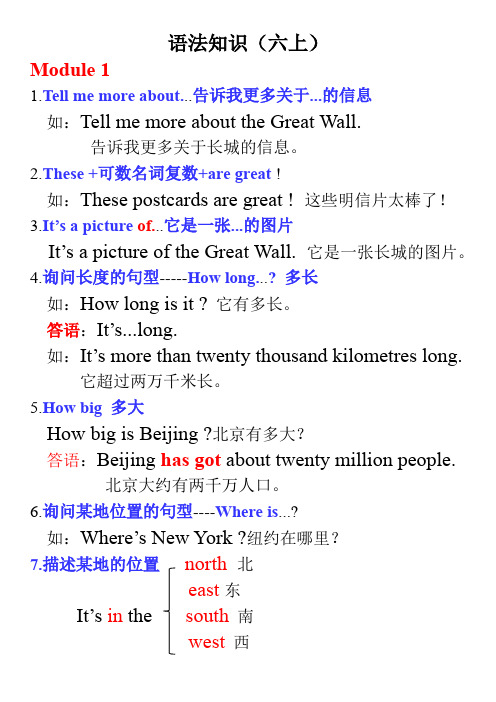
语法知识(六上)Module 11.Tell me more about...告诉我更多关于...的信息如:Tell me more about the Great Wall.告诉我更多关于长城的信息。
2.These +可数名词复数+are great !如:These postcards are great ! 这些明信片太棒了!3.It’s a picture of...它是一张...的图片It’s a picture of the Great Wall. 它是一张长城的图片。
4.询问长度的句型-----How long...? 多长如:How long is it ?它有多长。
答语:It’s...long.如:It’s more than twenty thousand kilometres long.它超过两万千米长。
5.How big 多大How big is Beijing ?北京有多大?答语:Beijing has got about twenty million people.北京大约有两千万人口。
6.询问某地位置的句型----Where is...?如:Where’s New York ?纽约在哪里?7.描述某地的位置north北east东It’s in the south南west1.描述某处有某人/某物的句型----There is /are...有如:There’s a Chinatown in New York.在纽约有一个唐人街。
There is + 可数名词单数/不可数名词There are + 可数名词复数There be结构的就近原则如:(1)There is a computer on the teacher’s desk.(2)There are many desks and chairs in the classroom.(3)There is a pen and many pencils in my bag.2.频度副词never sometimes often always从不有时经常总是3.强调句You do miss China !你确实想念中国。
外研版六年级上册m1-m10重点短语、句型、语法归纳
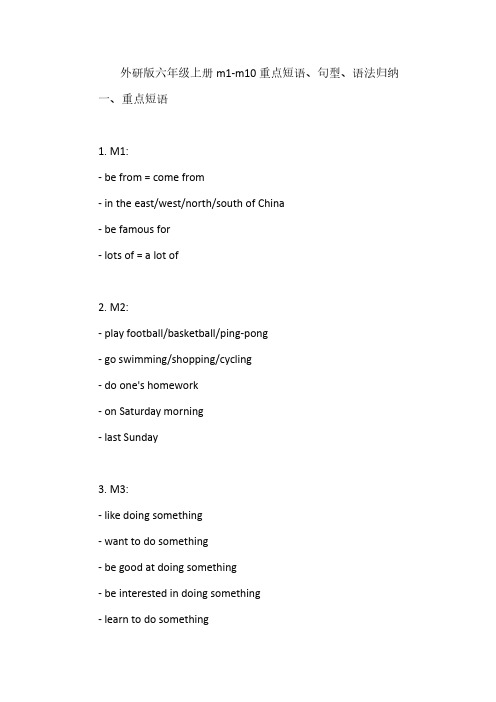
外研版六年级上册m1-m10重点短语、句型、语法归纳一、重点短语1.M1:-be from=come from-in the east/west/north/south of China-be famous for-lots of=a lot of2.M2:-play football/basketball/ping-pong-go swimming/shopping/cycling-do one's homework-on Saturday morning-last Sunday3.M3:-like doing something-want to do something-be good at doing something-be interested in doing something-learn to do something4.M4:-be going to do something-have a party-buy some presents-make some food-do some shopping5.M5:-there is/are-have got-would like to do something-show someone around-live in6.M6:-How long does it take to do something?-It takes someone some time to do something. -How far is it from A to B?-It's about...kilometers away.7.M7:-be different from-in the past-change a lot-keep healthy/fit-be good for8.M8:-be made of-be used for-be made in-be famous for-be known as9.M9:-prefer doing something to doing something -would rather do something than do something -as soon as possible-get ready for-prepare for10.M10:-wish to do something-hope to do something-plan to do something-decide to do something-try to do something二、重点句型1.M1:-Where are you from?-I'm from China.-What are you famous for?-We're famous for our beautiful mountains.2.M2:-What do you usually do on Saturday morning? -I usually play basketball.-What did you do last Sunday?-I went shopping.3.M3:-I like playing basketball.-She wants to learn to dance.-He is good at drawing.-They are interested in learning English.4.M4:-We are going to have a party next week.-I am going to buy some presents for my friends. -They are going to make some food for the party.5.M5:-There is a park near my home.-I have got a new bicycle.-Would you like to come to my party?-Can you show me the way to the museum?6.M6:-How long does it take to walk to school?-It takes me about30minutes to walk to school. -How far is it from your home to school?-It's about2kilometers away.7.M7:-Life in the past was very different from life today.-Things have changed a lot in the last few years. -We should keep healthy and fit.-Eating vegetables is good for our health.8.M8:-Pavilions are usually made of wood.-Chopsticks are used for eating rice.-This car is made in Japan.-China is famous for its tea.9.M9:-I prefer playing basketball to playing football. -I would rather stay at home than go out.-Please send the email as soon as possible.-We are getting ready for the English test.10.M10:-I wish to travel around the world.-She hopes to become a doctor in the future. -They plan to visit their grandparents tomorrow. -He decided to give up smoking.-She tries to finish her homework every day.三、语法归纳1.一般现在时:表示经常发生的动作或现在的状态。
最新外研版小学英语六年级上册语法知识汇总

烟店镇中心小学六年级小学阶段英语语法知识汇总一、词类:1、动词:行为动词、be动词、情态动词。
(1)行为动词原形、+s/es、+ed、+ing,具体判断方法如下:(2)be动词a、am-was is --was are--were 口诀:我用am, 你用are, is用在他她它,所有复数全用are。
b、肯定和否定句I am (not) from London. He /She is(not) a teacher. My hair is(not) long. Her eyes are(not) small.c、一般疑问句Am I …? Yes, you are. No, you aren’t. Are you/they…? Yes,we/ they are. No,we/ they aren’t. Is the cat fat? Yes, it is. No, it isn’t. is、am、are为一类,一般用于一般现在时、现在进行时和一般将来时中。
was和were为另一类,一般用于一般过去时。
(3)情态动词can、must、should、would、may。
情态动词后动词总是用原形。
(不受其他任何条件影响)2、名词这里强调两点:不可数名词都默认为单数,所以总是用is或者was。
如何加后缀:a.一般情况下,直接加-s,如:book-books, bag-bags, cat-cats, bed-beds b.以s. x. sh. ch结尾,加-es,如:bus-buses, box-boxes, brush-brushes, watch-watchesc.以“辅音字母+y”结尾,变y为i, 再加-es,如:family-families,strawberry-strawberriesd.以“f或fe”结尾,变f或fe为v, 再加-es,如:knife-knivese.不规则名词复数: man-men, woman-women, policeman-policemen, policewoman-policewomen, mouse-mice child-children foot-feet ,tooth-teeth , fish-fish, people-people, Chinese-Chinese, Japanese-Japanese 3形容词(包括副词)形容词表示某一事物的特征,副词表示某一动作的特征。
六年级外研上册知识点
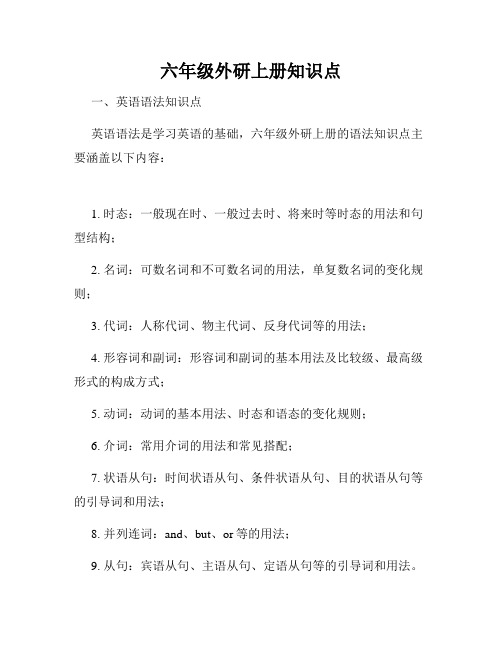
六年级外研上册知识点一、英语语法知识点英语语法是学习英语的基础,六年级外研上册的语法知识点主要涵盖以下内容:1. 时态:一般现在时、一般过去时、将来时等时态的用法和句型结构;2. 名词:可数名词和不可数名词的用法,单复数名词的变化规则;3. 代词:人称代词、物主代词、反身代词等的用法;4. 形容词和副词:形容词和副词的基本用法及比较级、最高级形式的构成方式;5. 动词:动词的基本用法、时态和语态的变化规则;6. 介词:常用介词的用法和常见搭配;7. 状语从句:时间状语从句、条件状语从句、目的状语从句等的引导词和用法;8. 并列连词:and、but、or等的用法;9. 从句:宾语从句、主语从句、定语从句等的引导词和用法。
二、词汇知识点词汇是语言表达的基本单位,六年级外研上册的词汇知识点主要包括以下内容:1. 动词:常见动词的基本形式、过去式和过去分词形式;2. 名词:常见名词的单数和复数形式;3. 形容词和副词:常见形容词和副词的原级、比较级和最高级形式;4. 数词:基数词和序数词的用法;5. 代词:人称代词、物主代词和指示代词的用法;6. 介词:常见介词的用法和搭配;7. 冠词:不定冠词和定冠词的用法;8. 疑问词:常见疑问词的用法;9. 前缀和后缀:常见前缀和后缀的构词规则。
三、句型知识点句型是句子的基本结构,六年级外研上册的句型知识点主要包括以下内容:1. 祈使句:表示请求、命令或建议的句型结构;2. 一般疑问句:以动词开头的一般疑问句及其回答;3. 特殊疑问句:以特殊疑问词开头的疑问句及其回答;4. 肯定句和否定句:肯定句和否定句的构成方式;5. 反意疑问句:在陈述句末尾加上反意疑问句的构成方式;6. 隐含句:省略主语、谓语、宾语等成分的句型;7. 并列句:使用并列连词连接的两个或多个句子。
四、阅读技巧知识点六年级外研上册的阅读技巧知识点主要包括以下内容:1. 预测题:根据标题、首段或图片等信息,预测文章的主题或大意;2. 细节理解题:通过理解文章中的具体细节,回答与之相关的问题;3. 推理题:根据文章中的提示信息,进行推理和判断;4. 词义猜测题:通过上下文的提示,猜测生词的意思;5. 主旨大意题:判断文章的中心思想或主题;6. 逻辑推理题:根据文章中的逻辑关系,进行推理和判断;7. 作者意图题:根据作者的写作目的,判断作者想要表达的观点或态度。
(完整版)外研版小学英语六年级上册语法知识点总结
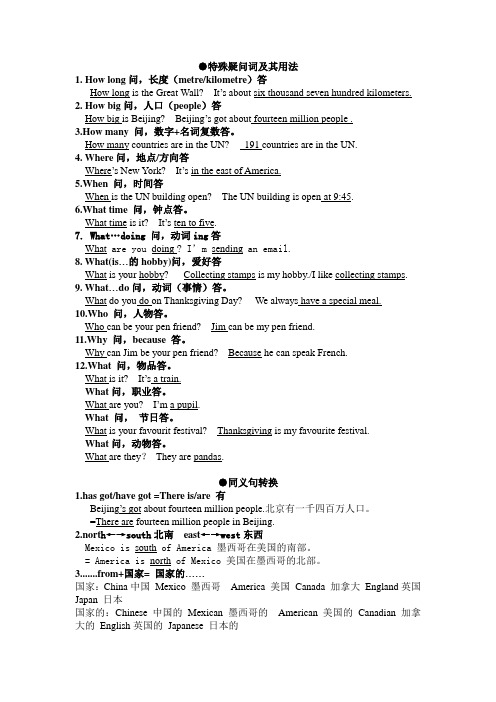
●特殊疑问词及其用法1. How long 问,长度(metre/kilometre)答How long is the Great Wall? It’s about six thousand seven hundred kilometers.2. How big 问,人口(people)答How big is Beijing? Beijing’s got about fourteen million people .3.How many 问,数字+名词复数答。
How many countries are in the UN? 191 countries are in the UN.4. Where问,地点/方向答Where’s New York? It’s in the east of America.5.When 问,时间答When is the UN building open? The UN building is open at 9:45.6.What time 问,钟点答。
What time is it? It’s ten to five.7. What…doing 问,动词ing答What are you doing ? I’m sending an email.8. What(is…的hobby)问,爱好答What is your hobby? Collecting stamps is my hobby./I like collecting stamps. 9. What…do问,动词(事情)答。
What do you do on Thanksgiving Day? We always have a special meal.10.Who 问,人物答。
Who can be your pen friend? Jim can be my pen friend.11.Why 问,because 答。
(完整版)外研版小学英语六年级上册语法知识点总结
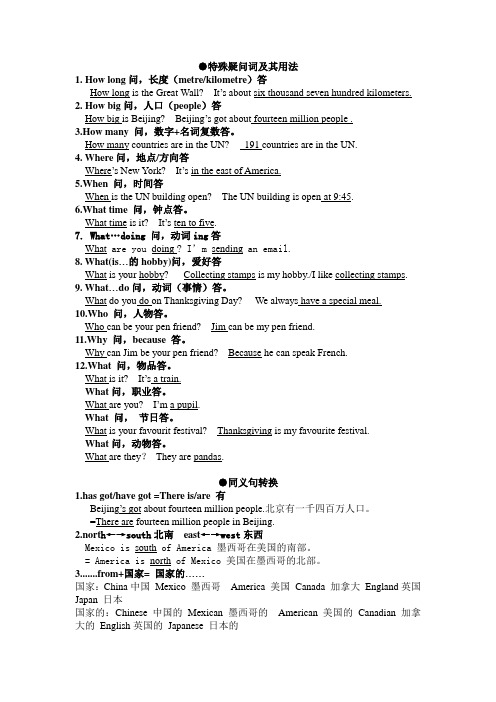
●特殊疑问词及其用法1. How long 问,长度(metre/kilometre)答How long is the Great Wall? It’s about six thousand seven hundred kilometers.2. How big 问,人口(people)答How big is Beijing? Beijing’s got about fourteen million people .3.How many 问,数字+名词复数答。
How many countries are in the UN? 191 countries are in the UN.4. Where问,地点/方向答Where’s New York? It’s in the east of America.5.When 问,时间答When is the UN building open? The UN building is open at 9:45.6.What time 问,钟点答。
What time is it? It’s ten to five.7. What…doing 问,动词ing答What are you doing ? I’m sending an email.8. What(is…的hobby)问,爱好答What is your hobby? Collecting stamps is my hobby./I like collecting stamps. 9. What…do问,动词(事情)答。
What do you do on Thanksgiving Day? We always have a special meal.10.Who 问,人物答。
Who can be your pen friend? Jim can be my pen friend.11.Why 问,because 答。
外研版六年级上册英语语法知识汇总

语法知识(六上)Module 1Tell me more about...告诉我更多对于 ...的信息如: Tell me more about the Great Wall.告诉我更多对于长城的信息。
These +可数名词复数 +are great !如: These postcards are great ! 这些明信片太棒了!It ’ s a pictureof...它是一张 ...的图片It ’ s a picture of the Great Wall它.是一张长城的图片。
咨询长度的句型 -----How long...? 多长如: How long is it ? 它有多长。
答语: It ’s...long.如: It ’s more than twenty thousand kilometres long.它超出两万千米长。
How big 多大How big is Beijing ?北京有多大?答语: Beijing has got about twenty million people.北京大概有两千万人口。
咨询某地地点的句型 ----Where is...?如: Where’s New York纽?约在哪里?7.描绘某地的地点north 北east 东It ’ s in the south 南west 西Module 2描绘某处有某人 / 某物的句型 ----There is /are...有如: There’s a Chinatown in New York.在纽约有一个唐人街。
There is + 可数名词单数 / 不行数名词There are + 可数名词复数There be 构造的就近原则(2)There are many desks and chairs in the classroom.(3)There is a pen and many pencils in my bag.频度副词never sometimes often always从不有时常常老是重申句You do miss China 你!的确思念中国。
知识点总结(知识清单)-2024-2025学年外研版(三起)英语六年级上册

外研版(三起)六年级英语上册单元知识点Module 1一、短语:1、the Great Wall长城2、visit the US拜访(参观、游玩)美国3、in New York在纽约4、look at 看...5、a picture of... 一张....图画(相片)6、tell me more about...多给我讲点关于...7、how long多长8、It`s about ...它是大约(关于)9、twenty thousand kilometres long 两万千米长10、tell me something about…告诉我关于...的事11、how big 多大12、eight million people 八百万人13、twenty million people 两千万人14、be great 太棒了15、an animal 一只动物16、in the east of… 在...的东部17、in the west/south/north of … 在...的西/南/北部18、San Francisco 旧金山19、a (big) map of... 一(大)张...地图20、lots of=a lot of=many/much 许多21、from...to.. 从....到......22、a big country一个大国23、every day and night 每日每夜二、句子1、These postcards are great ! 这些明信片真棒!Yes, they are. 是的,它们是。
2、Tell me more about the Great Wall.多给我讲点关于长城的3、How long is it? 它有多长?It’s more than twenty thousand kilometres long. 它有两万多千米长。
4、How big is it? 它有多大?It has got more than eight million people.它有八百多万人口。
完整版)外研版小学英语六年级上册语法知识点总结
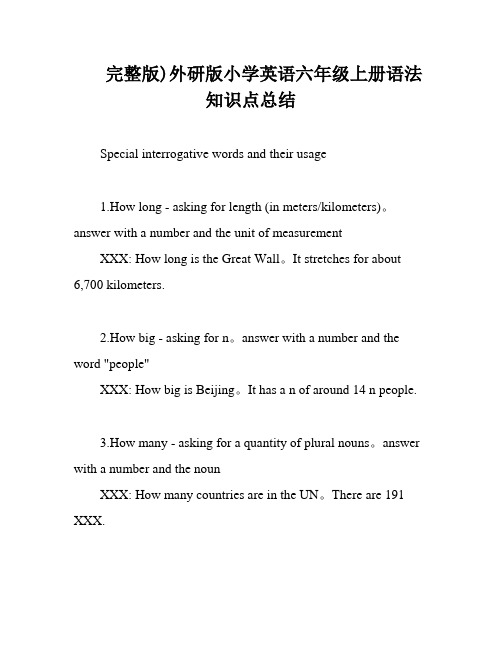
完整版)外研版小学英语六年级上册语法知识点总结Special interrogative words and their usage1.How long - asking for length (in meters/kilometers)。
answer with a number and the unit of measurementXXX: How long is the Great Wall。
It stretches for about 6,700 kilometers.2.How big - asking for n。
answer with a number and the word "people"XXX: How big is Beijing。
It has a n of around 14 n people.3.How many - asking for a quantity of plural nouns。
answer with a number and the nounXXX: How many countries are in the UN。
There are 191 XXX.4.Where - asking for a n or n。
answer with a specific place or nXXX: Where is New York。
It is XXX America.5.When - asking for a specific time。
answer with a time or a time rangeXXX: When is the UN building open。
It opens at 9:45.6.What time - asking for the current time。
answer with the timeXXX: What time is it。
外研版英语六年级上册语法知识点总结(精编)
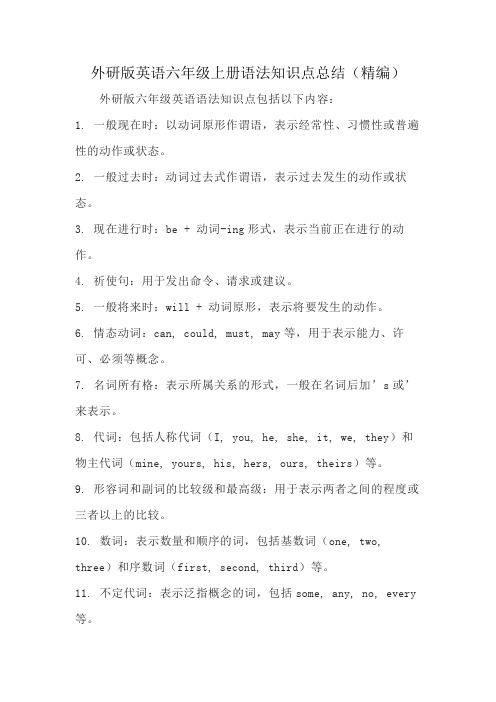
外研版英语六年级上册语法知识点总结(精编)外研版六年级英语语法知识点包括以下内容:1. 一般现在时:以动词原形作谓语,表示经常性、习惯性或普遍性的动作或状态。
2. 一般过去时:动词过去式作谓语,表示过去发生的动作或状态。
3. 现在进行时:be + 动词-ing形式,表示当前正在进行的动作。
4. 祈使句:用于发出命令、请求或建议。
5. 一般将来时:will + 动词原形,表示将要发生的动作。
6. 情态动词:can, could, must, may等,用于表示能力、许可、必须等概念。
7. 名词所有格:表示所属关系的形式,一般在名词后加’s或’来表示。
8. 代词:包括人称代词(I, you, he, she, it, we, they)和物主代词(mine, yours, his, hers, ours, theirs)等。
9. 形容词和副词的比较级和最高级:用于表示两者之间的程度或三者以上的比较。
10. 数词:表示数量和顺序的词,包括基数词(one, two, three)和序数词(first, second, third)等。
11. 不定代词:表示泛指概念的词,包括some, any, no, every 等。
12. 疑问词:用于提问的词,包括what, where, when, who, why等。
13. 定义性从句:用来对前面提到的名词或代词进行解释、说明的从句。
14. 时间状语从句:用于修饰主句,表示时间关系的从句。
15. 原因状语从句:用于修饰主句,表示原因关系的从句。
16. 结果状语从句:用于修饰主句,表示结果关系的从句。
17. 目的状语从句:用于修饰主句,表示目的关系的从句。
18. 条件状语从句:用于修饰主句,表示条件关系的从句。
外研版六上英语知识点总结
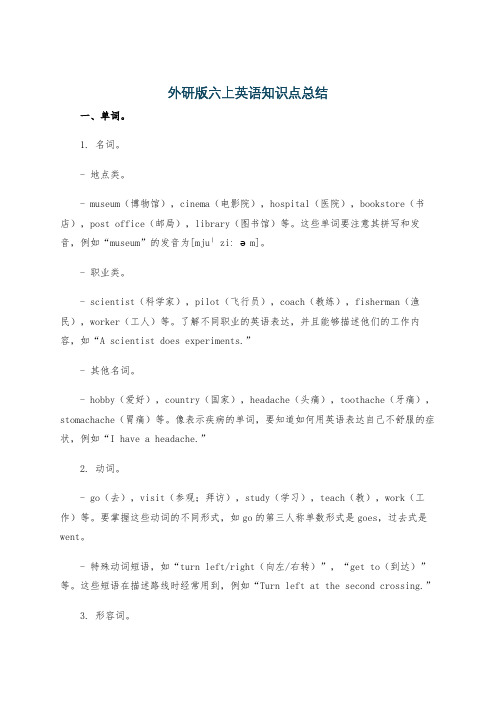
外研版六上英语知识点总结一、单词。
1. 名词。
- 地点类。
- museum(博物馆),cinema(电影院),hospital(医院),bookstore(书店),post office(邮局),library(图书馆)等。
这些单词要注意其拼写和发音,例如“museum”的发音为[mjuˈziːəm]。
- 职业类。
- scientist(科学家),pilot(飞行员),coach(教练),fisherman(渔民),worker(工人)等。
了解不同职业的英语表达,并且能够描述他们的工作内容,如“A scientist does experiments.”- 其他名词。
- hobby(爱好),country(国家),headache(头痛),toothache(牙痛),stomachache(胃痛)等。
像表示疾病的单词,要知道如何用英语表达自己不舒服的症状,例如“I have a headache.”2. 动词。
- go(去),visit(参观;拜访),study(学习),teach(教),work(工作)等。
要掌握这些动词的不同形式,如go的第三人称单数形式是goes,过去式是went。
- 特殊动词短语,如“turn left/right(向左/右转)”,“get to(到达)”等。
这些短语在描述路线时经常用到,例如“Turn left at the second crossing.”3. 形容词。
- happy(高兴的),sad(悲伤的),angry(生气的),afraid(害怕的),ill(生病的)等。
能够用这些形容词描述人物的情绪或身体状态,例如“He is ill. He looks sad.”二、短语。
1. 交通方式短语。
- by bike(骑自行车),by bus(乘公共汽车),by subway(乘地铁),by train(乘火车),on foot(步行)等。
注意“by +交通工具”中间不加冠词,而“on foot”是固定表达。
外研版英语六年级(上册)语法知识点详解
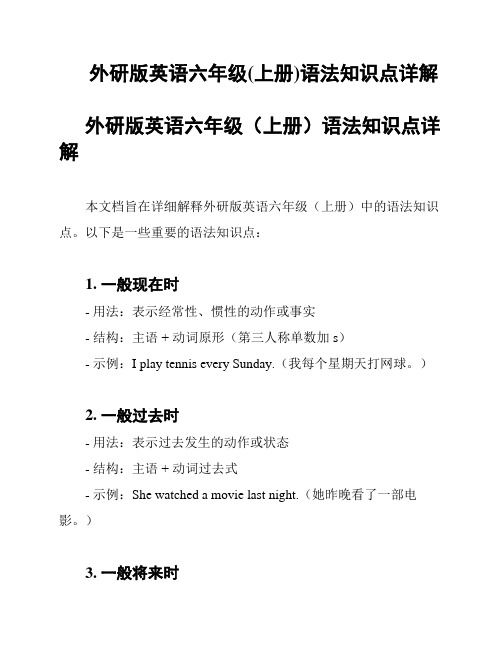
外研版英语六年级(上册)语法知识点详解外研版英语六年级(上册)语法知识点详解本文档旨在详细解释外研版英语六年级(上册)中的语法知识点。
以下是一些重要的语法知识点:1. 一般现在时- 用法:表示经常性、惯性的动作或事实- 结构:主语 + 动词原形(第三人称单数加s)- 示例:I play tennis every Sunday.(我每个星期天打网球。
)2. 一般过去时- 用法:表示过去发生的动作或状态- 结构:主语 + 动词过去式- 示例:She watched a movie last night.(她昨晚看了一部电影。
)3. 一般将来时- 用法:表示将来发生的动作或状态- 结构:主语 + will + 动词原形- 示例:I will go to Beijing next week.(下周我将去北京。
)4. 现在进行时- 用法:表示现在正在进行的动作- 结构:主语 + am/is/are + 动词ing- 示例:They are playing soccer in the park.(他们正在公园踢足球。
)5. 物主代词- 用法:表示所属关系或归属- 结构:my, your, his, her, its, our, their- 示例:This is my book.(这是我的书。
)6. 一般疑问句- 用法:用于提问- 结构:助动词/系动词/情态动词 + 主语 + 动词原形?- 示例:Do you like ice cream?(你喜欢冰淇淋吗?)7. 否定句- 用法:用于否定- 结构:主语 + do/does/did + not + 动词原形- 示例:She does not speak French.(她不会说法语。
)请注意,以上只是一部分语法知识点的概述。
在研究过程中,建议详细阅读教材并做练,以更好地掌握这些语法知识点。
祝您研究进步!。
外研版小学英语六年级上册语法知识点总结15250

外研版小学英语六年级上册语法知识点总结•特殊疑问词及貝用法」1. How long 问* 氏庭(metre/kilo metre )答1How grt® 冷the Great Wall? It* 5 aibout six thQuw&门d sev口门tiundrwd lc0Qm 亡t 己FS-42- How big in) *人口( people )答-:How big is Beijtncj? BeijFnq3 4 5 6 s qot about fourteen miliion people . 43.How many 问.数字十名同貝敢答。
*How m^ny countries are in the UN? 191 countries are in the UN^4・Where问,地点/右向誓WHEfe7 s New York? lt r s in the east of Am巳「ica.^5 .When问・时问答*When is the UN building open? The UN building is open at 9:45.^ 6-What time 问,钟点脅。
*Whnt timm is it? If s ten to five.^7* What...doing 问t动i司ing 'Wtiat are you doing ? l r m 翠口岂口©an emaiL+J5 WhBt(is….te hobby)I R I,脣好笞』WTi己t is your hobby? Coll巳cting 刍t白rr|j£ is my hobby./I like collecting s tamps.^i-'9. What-»do lb).动词{事情)警.讨What do you de on Thanksgiving Day? We aIways have a special meaL^310-Who 问(人物答.亠 WHo 匚日n be your pen friend? Jim can be my pen friends 11. Why 问,because 亀卩Why can Jim be your pen friend? Bee 白U5亡 he speak French.*^12. What 问,物品答"aWhat is it? It r 5 a trainsWhat 何T 职业答*卜What are you? T m a pupilsWhat 问,节曰答血衬What is /our favouril festival? Thanksgiving is my favourite festival.^What 问r 动频答□ 4What are they ? They are pandas^■同支旬转换-1. ha5 got/have got -There is/are 有宀Beijing s got about fourteen millron pspleH 匕京有一于四百万人口口 心=There are fourteen million people in Beijing.#2. north —^south 北函 ea&t —west 乐西卩Mexico is south of America 星西昌在簧国的南部口心=America is north of Mexico 美国在墨西哥的北部"心国: China 中国 Mexico SE® America 美国 Canada 加拿大 Enqiandfrom + 赛=国東的英国Japan曰本国家的:Chinese中国的Mexican奎西哥的American美国的Canadian 加拿大的English英国的Japanese日K的*This &tamp fe from China 中国的亠=This is a Chinese stamp.这一枚中国的由*斗.be frQrn = come from 来自宅These stamps 3「已f「onn my letters^1=These stamps匸0巾已from my I吕口电「乳这些出B票来目我的信& ,5- give AMI®=give M;g5 to 某人绪……匕He gives thE QhilEFen pre*n恰-他给孩子们礼物a=He give^ to thm 亡皿1厲丁电门«1^6木14^孑袤刊口* <-■石.{・••的)hobby=...like ............................ 的爰好二・・・■喜恢・・・4Collecting stamps Is my hobby.gflpg^atj^j!?^ a=IJike collecting砒amp呂.我喜欢集由久u7- lots of -manyThere are 1。
外研版六年级上册英语全册知识清单考点汇总
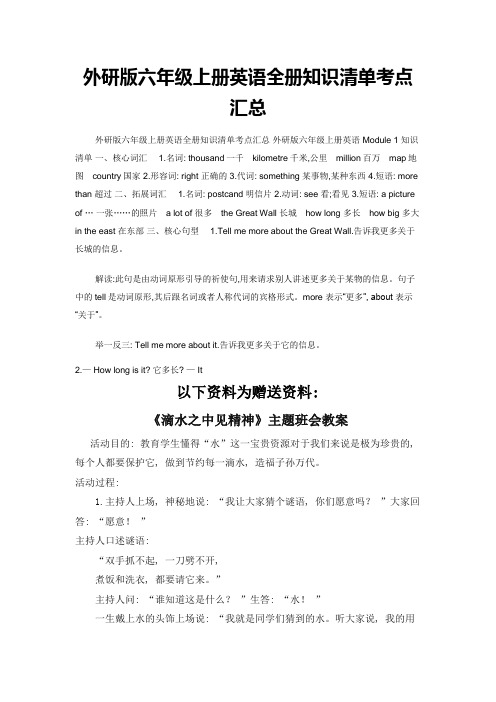
外研版六年级上册英语全册知识清单考点汇总外研版六年级上册英语全册知识清单考点汇总外研版六年级上册英语 Module 1 知识清单一、核心词汇 1.名词: thousand一千kilometre千米,公里million百万map地图country国家 2.形容词: right 正确的 3.代词: something 某事物,某种东西 4.短语: more than 超过二、拓展词汇 1.名词: postcand 明信片 2.动词: see 看;看见 3.短语: a picture of …一张……的照片 a lot of 很多the Great Wall 长城how long 多长how big 多大in the east 在东部三、核心句型 1.Tell me more about the Great Wall.告诉我更多关于长城的信息。
解读:此句是由动词原形引导的祈使句,用来请求别人讲述更多关于某物的信息。
句子中的tell是动词原形,其后跟名词或者人称代词的宾格形式。
more 表示“更多”, about 表示“关于”。
举一反三: Tell me more about it.告诉我更多关于它的信息。
2.— How long is it? 它多长? — It以下资料为赠送资料:《滴水之中见精神》主题班会教案活动目的: 教育学生懂得“水”这一宝贵资源对于我们来说是极为珍贵的, 每个人都要保护它, 做到节约每一滴水, 造福子孙万代。
活动过程:1.主持人上场, 神秘地说: “我让大家猜个谜语, 你们愿意吗?”大家回答: “愿意!”主持人口述谜语:“双手抓不起, 一刀劈不开,煮饭和洗衣, 都要请它来。
”主持人问: “谁知道这是什么?”生答: “水!”一生戴上水的头饰上场说: “我就是同学们猜到的水。
听大家说, 我的用处可大了, 是真的吗?”主持人: 我宣布: “水”是万物之源主题班会现在开始。
水说: “同学们, 你们知道我有多重要吗?”齐答: “知道。
外研版小学六年级上册英语语法知识汇总
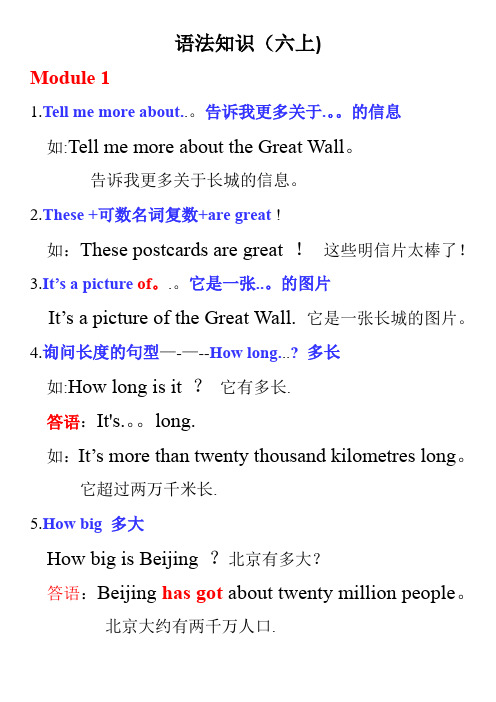
语法知识(六上)Module 11.Tell me more about..。
告诉我更多关于.。
的信息如:Tell me more about the Great Wall。
告诉我更多关于长城的信息。
2.These +可数名词复数+are great !如:These postcards are great !这些明信片太棒了!3.It’s a picture of。
.。
它是一张..。
的图片It’s a picture of the Great Wall. 它是一张长城的图片。
4.询问长度的句型—-—--How long...? 多长如:How long is it ?它有多长.答语:It's.。
long.如:It’s more than twenty thousand kilometres long。
它超过两万千米长.5.How big 多大How big is Beijing ?北京有多大?答语:Beijing has got about twenty million people。
北京大约有两千万人口.6.询问某地位置的句型—-—-Where is..。
?如:Where's New York ?纽约在哪里?7.描述某地的位置north北east东It's in the south南west西Module 21.描述某处有某人/某物的句型—---There is /are。
..有如:There's a Chinatown in New York.在纽约有一个唐人街。
There is + 可数名词单数/不可数名词There are + 可数名词复数There be结构的就近原则如:(1)There is a computer on the teacher’s desk.(2)There are many desks and chairs in the classroom.(3)There is a pen and many pencils in my bag。
- 1、下载文档前请自行甄别文档内容的完整性,平台不提供额外的编辑、内容补充、找答案等附加服务。
- 2、"仅部分预览"的文档,不可在线预览部分如存在完整性等问题,可反馈申请退款(可完整预览的文档不适用该条件!)。
- 3、如文档侵犯您的权益,请联系客服反馈,我们会尽快为您处理(人工客服工作时间:9:00-18:30)。
语法知识(六上)Module 1
1. Tell me more about...告诉我更多关于...的信息
如:Tell me more about the Great Wall.
告诉我更多关于长城的信息。
2. These +可数名词复数+are great !
如:These postcards are great ! 这些明信片太棒了!
3. It’s a picture of...它是一张...的图片
It’s a picture of the Great Wall. 它是一张长城的图片。
4. 询问长度的句型-----How long...? 多长
如:How long is it ?它有多长。
答语:It’s...long.
如:It’s more than twenty thousand kilometres long.
它超过两万千米长。
5. How big 多大
How big is Beijing ?北京有多大?
答语:Beijing has got about twenty million people.
北京大约有两千万人口。
6. 询问某地位置的句型----Where is...?
如:Where’s New York ?纽约在哪里?
7.描述某地的位置north北
east东
It’s in the south南
west西
Module 2
1. 描述某处有某人/某物的句型----There is /are...有
如:There’s a Chinatown in New York.
在纽约有一个唐人街。
There is + 可数名词单数/不可数名词
There are + 可数名词复数
There be结构的就近原则
如:(1)There is a computer on the teacher’s desk.
(2)There are many desks and chairs in the classroom.
(3)There is a pen and many pencils in my bag.
2. 频度副词
never sometimes often always
从不有时经常总是
3. 强调句
You do miss China !你确实想念中国。
4. Let’s=let us + 动词原形
Let’s go to Chinatown now !让我们现在去唐人街吧!Module 3
1.用I’ve got ...表达“我有...”
如:I’ve got lots of stamps.我有许多邮票。
2.询问对方是否有某物的句型-----Have you got...?
如:Have you got any dolls from Japan ?
你有一些来自日本的玩具娃娃吗?
肯定回答:Yes, I have. 是的,我有。
否定回答:No,I haven’t. 不,我没有。
3.表达自己业余爱好的句型-----is my hobby.
如:Collecting stamps is my hobby.
收集邮票是我的业余爱好。
4.介绍来自某地的某物-----These are...from...
如:These are stamp s from Canada.
这些是来自加拿大的邮票。
5.询问对方的业余爱好的句型----What’s your hobby ?
如:What’s your hobby, Taotao?
你的业余爱好是什么,涛涛?
答语:(1)Fly ing kites is my hobby.放风筝是我的业余爱好。
(2)My hobby is fly ing kites.我的业余爱好是放风筝。
6.Some 和any. (见《同步学习》16页。
Module 4
1. 说出自己最喜欢的节日
----....is my favourite festival.如:Thanksgiving is my my favourite festival.
感恩节是我最喜欢的节日。
2. 表达“我们总是......”的句型------We always...
We always have a special meal.我们总是吃一顿特殊的饭。
3. 表达“向...表示感谢”的句型------...say “thank you” for ...
如:On Thanksgiving Day we say “thank you” for our food,family and friends. 在感恩节我们向我们的食物、家人和朋友说“谢谢你”。
4. 连系动词sound
That sound s nice.那听起来很好。
5. 主格
(I, you, he, she, it,we, they)与宾格(me, you, him, her, it, us, them)
见《同步学习》19页。
Module 5
1.
初次见面时打招呼的句型----Please d to meet you !
很高兴见到你!2. 情态动词can 引导的一般疑问句 can + 动词原形
Can you speak English ?你会说英语吗?
肯定回答:Yes, I can. 是的,我会。
否定回答:No, I can’t.不,我不会。
3.描述某人具有某种能力----...can ...
I can speak some English.我会说一些英语。
4.Like + 动词ing
I like collect ing stamps. 我喜欢收集邮票。
Module 6
1.表达某人有某物-----...have/has got... 有
You’ve got a letter from New York, but it’s not from Daming.你们有一封来自纽约的信,但是它不是来自大明。
第三人称单数作主语时用has got
Daming has got some pen friends. 大明有一些笔友。
2.
连词and 和 but (见《同步学习》30页)。
